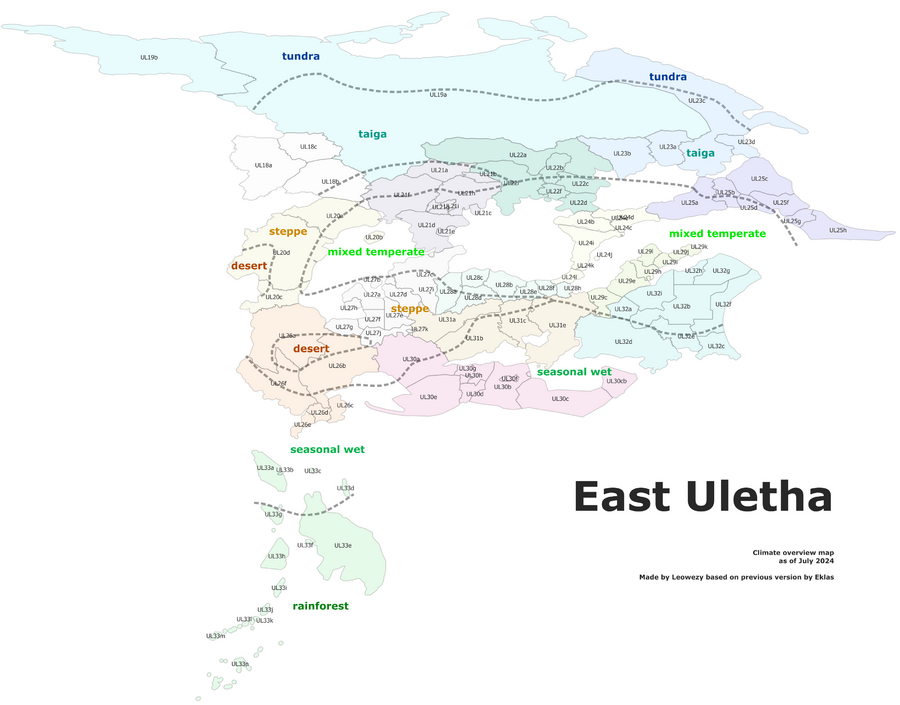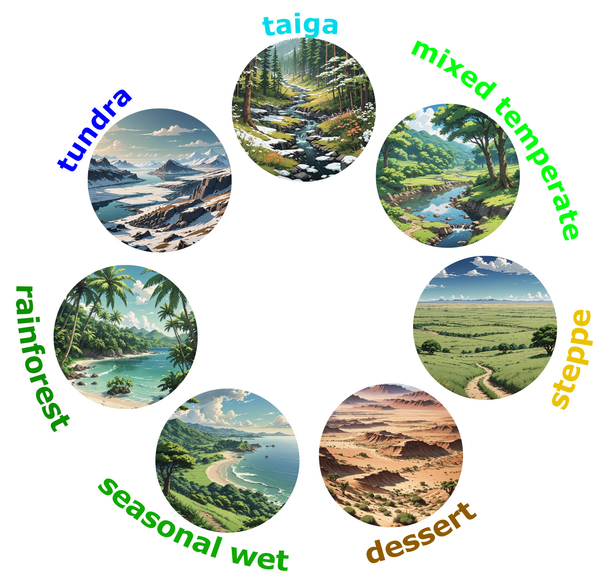OpenGeofiction:East Uletha
This page is dedicated to admin plans concerning the development and organization of East Uletha.
Sectors and commentary
- Cultural target-theme: new territories should either align with these or make a convincing case of how their concept fits in otherwise/justifies a change to the target-theme for the sector.
- Challenges: deviations from the cultural or geographical targets of this concept, low mapping quality, high activity
- Advantages: examples of good alignment with the cultural or geographical targets of this concept, high mapping quality, low activity
- Proposals and projects: outstanding admin-orga work to foster a better alignment in the future
Sector 18 (East Ulethan Taiga)
- Cultural target-theme: none yet
- Challenges: none (both countries are empty)
- Advantages: Blank area with great potential for interesting mapping
- Proposals and projects:
- 18a – Reserved for a multi-owner collaborative territory, possibly with a Slavic theme.
- 18b – Available to experienced users mainly interested in mapping natural features.
Sector 19 (Polar East)
- Cultural target-theme: native arctic themes
- Challenges: none (both countries are empty)
- Advantages: Likely a vast area of taiga, tundra and other unique subpolar vegetation types
- Proposals and projects:
- 19a – Reserved for collaborative territory with native subpolar (native Siberian or North American, non-Russian) theme.
- 19b – Available to experienced users mainly interested in mapping natural features.
Sector 20 (Central Ulethan Steppe)
- Cultural target-theme: slavic influence from the west, possibly also north-eastern European or some Germanic influence from the East
- Challenges: Large grey area
- Advantages: Convenient location in Central Uletha, could be an interesting melting pot for various languages and cultures with strong slavic influence.
- Proposals and projects:
- 20c – "Little Sister" of Midistland in terms of function as chokepoint.
Sector 21 (Temperate East Uletha I)
- Cultural target-theme: Germanic/Finnish
- Challenges: unexplainable mix of Germanic, Finnish and Romance languages
- Advantages: some consistent large-scale mapping, nice coastline and natural feature mapping
- Proposals and projects:
- UL21c – should be cleaned up. Delete, move or recreate "Vatican" equivalent elsewhere, most likely in west Uletha
- UL21d/e – would User jak consider moving to a romance/Italian speaking area? Remaining Germanic theme would fit well with other territories around the Darcodian sea.
Sector 22 (Temperate East Uletha II)
- Cultural target-theme: Germanic/Northern European
- Challenges:
- Advantages: Good large-scale mapping across the sector. Countries in this sector are generally owned by experienced users, they have overall good mapping quality and appropriate use of languages and culture. No significant changes are to be expected in the area.
- Proposals and projects:
- General – none
Sector 23 (Emerald Sea North)
- Cultural target-theme: native artic, conlang, regional colonial influences
- Challenges: Only one active territory. Requires restrained, cold-climate mapping.
- Advantages: none
- Proposals and projects:
- General – none
Sector 24 (Nautical East Uletha)
- Cultural target-theme: Germanic
- Challenges: All territories occupied
- Advantages: Good sea access and optimal climate, consistent Germanic language theme
- Proposals and projects:
- General – None
Sector 25 (Whale Sea states)
- Cultural target-theme: Germanic/Northern European, Celtic, Conlangs
- Challenges: Incoherent mix of Scandinavian, French and English
- Advantages: Interesting cold oceanic theme
- Proposals and projects:
- None
Sector 26 (Ulethan Mideast)
- Cultural target-theme: South Asian (Indian) and (mostly native) Austronesian
- Challenges: besides Midistland no active territories
- Advantages: Reserve sector
- Proposals and projects:
- General – None
Sector 27 (Kaspen Sea countries)
- Cultural target-theme: expansion of Germanic theme along the Kaspian sea, transitioning into South-Asian/Austronesian and East Asian towards sectors 26 and 30
- Challenges: few active territories
- Advantages:
- Proposals and projects:
- General
Sector 28 (South Darcodian Sea Coast)
- Cultural target-theme: Germanic, Conlangs
- Challenges: small size of territories neccessitates strong collaboration for large-scale geographic features. Some isolated languages.
- Advantages: active, strong Germanic theme
- Proposals and projects:
- General – None
Sector 29 (Lantian Peninsula)
- Cultural target-theme: Early Ingerish Colonial influence (~10th to 16th century) with early independence (17th century) and more "old-world" feel than FSA. Possibly also native influences ranging from Germanic (north) to East Asian (south) substrates.
- Challenges:
- Advantages: Mostly uniform English-speaking, attractive temperate and coastal territories
- Proposals and projects:
- General – None
Sector 30 (Axian Peninsula)
- Cultural target-theme: Japanese, possibly also related Conlangs, Korean, or other East Asian languages (other than Chinese), transitioning into South Asian/Austronesian in the West
- Challenges:
- Advantages:
- Proposals and projects:
- General
- UL30c: Nihonish homeland
Sector 31 (East Ulethan Grassland)
- Cultural target-theme: East Asian, Conlangs
- Challenges: developing East Ulethan mountain chain
- Advantages: active territories
- Proposals and projects:
- 31a – Territory reserved for highly mountainous mapping; will have to serve a bridging-function for the very different culture themes surrounding it. Could perhaps follow a "Switzerland"-model (collab?).
Sector 32 (Monsoon East Uletha)
- Cultural target-theme: transitioning sector between Ingerish-Colonial-on-East-Asian Substrate (north), Nihonish (south) and Nihonish-related Conlangs (west)
- Challenges: none
- Advantages: none
- Proposals and projects:
- General – None
Sector 33 (Tropical South Uletha)
- Cultural target-theme: Colonial Tropical Islands, Carribean
- Challenges: none
- Advantages: An area with generally good mapping quality, coherent language and climate scheme
- Proposals and projects: none

